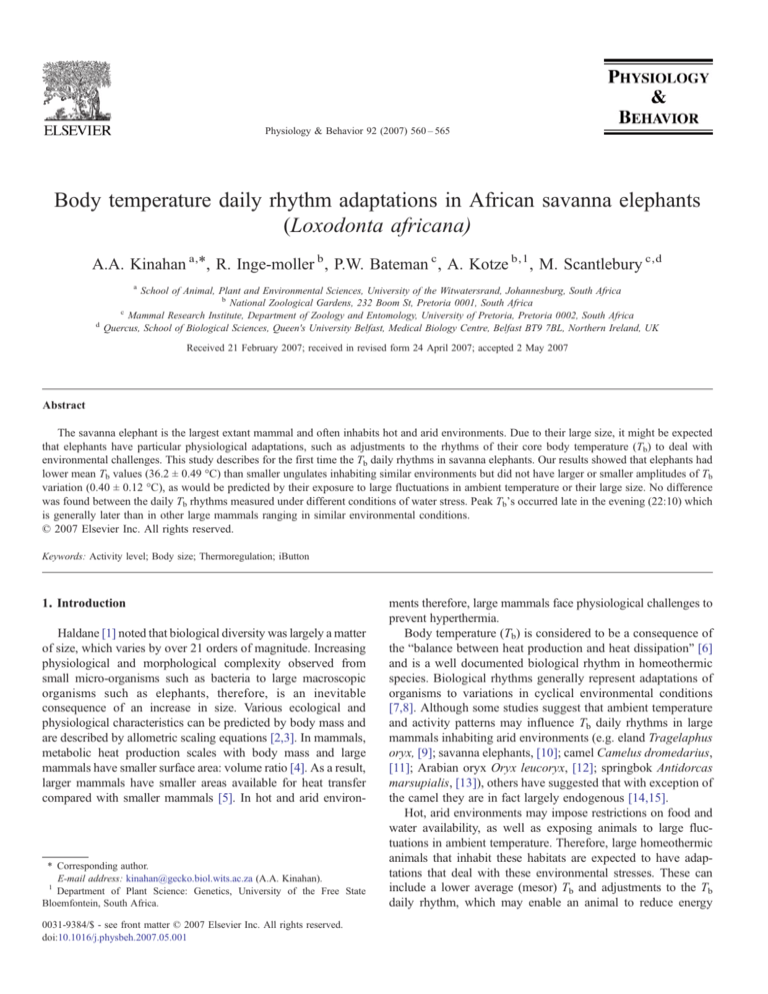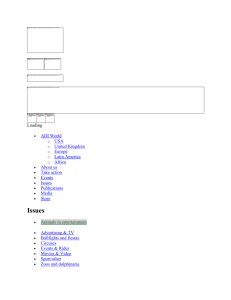
Physiology & Behavior 92 (2007) 560 – 565
Body temperature daily rhythm adaptations in African savanna elephants
(Loxodonta africana)
A.A. Kinahan a,⁎, R. Inge-moller b , P.W. Bateman c , A. Kotze b,1 , M. Scantlebury c,d
a
d
School of Animal, Plant and Environmental Sciences, University of the Witwatersrand, Johannesburg, South Africa
b
National Zoological Gardens, 232 Boom St, Pretoria 0001, South Africa
c
Mammal Research Institute, Department of Zoology and Entomology, University of Pretoria, Pretoria 0002, South Africa
Quercus, School of Biological Sciences, Queen's University Belfast, Medical Biology Centre, Belfast BT9 7BL, Northern Ireland, UK
Received 21 February 2007; received in revised form 24 April 2007; accepted 2 May 2007
Abstract
The savanna elephant is the largest extant mammal and often inhabits hot and arid environments. Due to their large size, it might be expected
that elephants have particular physiological adaptations, such as adjustments to the rhythms of their core body temperature (Tb) to deal with
environmental challenges. This study describes for the first time the Tb daily rhythms in savanna elephants. Our results showed that elephants had
lower mean Tb values (36.2 ± 0.49 °C) than smaller ungulates inhabiting similar environments but did not have larger or smaller amplitudes of Tb
variation (0.40 ± 0.12 °C), as would be predicted by their exposure to large fluctuations in ambient temperature or their large size. No difference
was found between the daily Tb rhythms measured under different conditions of water stress. Peak Tb's occurred late in the evening (22:10) which
is generally later than in other large mammals ranging in similar environmental conditions.
© 2007 Elsevier Inc. All rights reserved.
Keywords: Activity level; Body size; Thermoregulation; iButton
1. Introduction
Haldane [1] noted that biological diversity was largely a matter
of size, which varies by over 21 orders of magnitude. Increasing
physiological and morphological complexity observed from
small micro-organisms such as bacteria to large macroscopic
organisms such as elephants, therefore, is an inevitable
consequence of an increase in size. Various ecological and
physiological characteristics can be predicted by body mass and
are described by allometric scaling equations [2,3]. In mammals,
metabolic heat production scales with body mass and large
mammals have smaller surface area: volume ratio [4]. As a result,
larger mammals have smaller areas available for heat transfer
compared with smaller mammals [5]. In hot and arid environ-
⁎ Corresponding author.
E-mail address: kinahan@gecko.biol.wits.ac.za (A.A. Kinahan).
1
Department of Plant Science: Genetics, University of the Free State
Bloemfontein, South Africa.
0031-9384/$ - see front matter © 2007 Elsevier Inc. All rights reserved.
doi:10.1016/j.physbeh.2007.05.001
ments therefore, large mammals face physiological challenges to
prevent hyperthermia.
Body temperature (Tb) is considered to be a consequence of
the “balance between heat production and heat dissipation” [6]
and is a well documented biological rhythm in homeothermic
species. Biological rhythms generally represent adaptations of
organisms to variations in cyclical environmental conditions
[7,8]. Although some studies suggest that ambient temperature
and activity patterns may influence Tb daily rhythms in large
mammals inhabiting arid environments (e.g. eland Tragelaphus
oryx, [9]; savanna elephants, [10]; camel Camelus dromedarius,
[11]; Arabian oryx Oryx leucoryx, [12]; springbok Antidorcas
marsupialis, [13]), others have suggested that with exception of
the camel they are in fact largely endogenous [14,15].
Hot, arid environments may impose restrictions on food and
water availability, as well as exposing animals to large fluctuations in ambient temperature. Therefore, large homeothermic
animals that inhabit these habitats are expected to have adaptations that deal with these environmental stresses. These can
include a lower average (mesor) Tb and adjustments to the Tb
daily rhythm, which may enable an animal to reduce energy
A.A. Kinahan et al. / Physiology & Behavior 92 (2007) 560–565
consumption and water loss [16]. The savanna elephant
(Loxodonta africana) is the largest extant terrestrial mammal
and occurs in a wide range of habitats from savannas to deserts
[18]. In these habitats, water sources are often sparse and peak
ambient temperatures may reach up to 50 °C at certain times of the
year [18] with hot dry season daily fluctuations in some regions
ranging from approximately 8 °C at night to well over 40 °C
during the day (A.A Kinahan unpublished data). Elephants do not
possess sweat glands but cool themselves using transepidermal
water loss [19]. They also often make use of free standing water in
which to wallow and bathe [19] and their large ears act as thermal
windows [20]. In addition, recent work has shown that during the
hot dry season in Zambia, free-ranging elephants select shaded
habitats in the heat of the day and select landscapes that facilitate
heat loss during the cool evenings [21]. However, due to the
difficulty in obtaining physiological parameters from such
animals, little information is available on the body temperature
of savanna elephants (with the exception of 10, 22, 23) and no
studies that we are aware of have attempted to examine their Tb
daily rhythms.
The aims of the current study therefore were to (i) measure and
describe Tb daily rhythms in savanna elephants, (ii) determine
whether these rhythms were consistent with expectations of animals living in a hot environment with large daily fluctuations in
ambient temperature, independent of body size, and (iii) determine whether Tb daily rhythms varied with water stress.
561
2.2. Daily rhythms of body temperature (Tb )
Body temperatures of elephants were obtained by handfeeding them iButtons that were set to record every 30 min. This
technique has previously been used to measure Tb in African and
Asian circus elephants during transportation [26]. Gastrointestinal
temperatures recorded by ingested temperature sensors have been
shown to be reliable indicators of core body temperature in
hindgut fermenters [27]. Initially, we used model DS1921G
iButtons but since this did not give us sufficient resolution to
measure Tb we used model DS1922 L (± 0.0625 °C). iButtons
were sewn into pockets of rip-stop nylon [26] which included a
30 cm strand of trailing material. They were inserted into the
centre of an apple before being fed to elephants. This provided
some protection and also allowed iButtons to be readily identified
in dung that had been passed. iButtons were retrieved by
examining the dung in the enclosure each morning. Data were
downloaded using iButton-TMEX software version 3.21 (2004
Dallas Semiconductor MAXIM Corporation). Using the data
traces, we were able to determine how long iButtons remained in
the stomach of the elephants (in which temperatures were slightly
variable, because of the ingestion of food and water which was at
a lower temperature) and how long they remained in the lower
intestine (in which recorded temperatures provided reliable
measurements of core body temperature).
2.3. Experimental design
2. Materials and methods
2.1. Animals and housing
Four individual adult African elephants (ranging 20–30 years)
(1 male [M] and 3 females [F1 F2 and F3]) from the National
Zoological Gardens in Pretoria, South Africa were used for this
study. Elephants were housed in an outdoor enclosure during the
day and at night throughout this study (9143 m2) but were moved
to a smaller enclosure each morning (300 m2) whilst the larger
enclosure was being cleaned (approximately 08:00–09:00).
During this time the male was housed in a non-climate controlled
indoor enclosure (314 m2). We were not able to measure body
mass directly but we estimated the male to weight between 5.5
and 7.0 metric tonnes and the females to weigh between 2.0–
3.0 metric tonnes [24], with shoulder heights averaging 3.3 m for
adult males and 2.7 m for adult females [25]. Data were obtained
between October and November 2005, during the hot season and
before the onset of heavy summer rains. A daily ration of 40 kg
pumpkin, 20 kg gem squash, 15 kg butternut, 20 kg carrots, 30 kg
beetroot, 20 loaves of bread, 20 kg potatoes and ad libitum dry teff
was offered. Ambient temperature was recorded every 30 min for
the duration of the experiment by placing three iButtons®
(Thermochron, Dallas Semiconductors, Maxim Integrated Products, Inc., Sunnyvale, CA) (model DS1921G; ± 0.5 °C) at
different locations around the enclosure. The iButtons were
placed below plastic discs so they were shaded from direct
sunlight and secured in three different random locations around
the enclosure at a height of approximately 2 m, to obtain the mean
ambient temperature of the enclosure.
Elephants were fed iButtons under two different conditions in
which we varied water stress. Individuals were enticed to the
edge of their enclosure (by feeding them part of their daily
ration) and trained to stand under hosepipes for 10-minute
periods. We were careful to wet the entire animal (head, neck,
ears, back and stomach). This was done twice per day at
approximately 11:00 and 15:00. During weeks 1–2, individuals
M and F1 were sprayed (F2 and F3 were not sprayed). During
weeks 3–4, F2 and F3 were sprayed (M and F1 were not
sprayed). We fed the elephants iButtons at approximately 8:00
and 15:00 on alternate days in an attempt to obtain at least 5 days
worth of measurements for each animal under each treatment.
Throughout the study the elephants were allowed continuous
access to their normal water supply, which included a pool
(300 m2 and up to 2 m deep) and a drinking trough.
2.4. Data analysis
We used cosinor analysis to determine the Tb daily rhythms
of measured individuals [28,29] using the program Chrono2
(J.W.H. Ferguson, University of Pretoria). The period was assumed to be 24 h. We calculated the mean (mesor) values, the
amplitude and the phase angle (Acrophase) of the Tb daily
rhythms for each individual. The significances of the fitted
curves were tested against the null hypothesis that the amplitude
was zero [29]. The percentage of the variability in the data that
could be accounted for by the fitted curve (percentage rhythm)
was also calculated. We determined the curves that described
groups of individuals within treatments (unsprayed and sprayed)
562
A.A. Kinahan et al. / Physiology & Behavior 92 (2007) 560–565
and whether they were significantly different from one another.
We also determined whether Tb daily rhythms differed between
treatments (i.e. unsprayed versus sprayed) [30].
3. Results
3.1. Ambient conditions
A one-way repeated measures ANOVA showed that no intervariation occurred between the ambient temperatures around the
enclosure recorded by each of the iButtons. Mean ambient
temperature throughout the study period was 21.5 ± 0.19 °C
(maximum = 37.7 °C, minimum = 11.2 °C).
3.2. Data retrieval
iButtons were recovered between 2 and 7 days after they had
been fed to elephants. The mean gut transit period was 65.2 ±
36.5 h. The mean period that the iButtons remained in the
animals stomach was 4.4 ± 2.2 h (range 2 to 9 h). The overall
success in retrieving data from iButtons was low. Of the 40 that
were fed to elephants, 2 were never retrieved and 32 appeared to
be intact when retrieved however could not be read. We were
only able to obtain data from the male and two of the females
(F1 and F2). We therefore present data from six iButtons. It
should be noted, that changing the feeding regime from placing
the apples in the elephant's trunk to directly placing them in
their mouths improved chances of successfully retrieving data
from the iButtons.
3.3. Daily rhythms of body temperature (Tb)
Across all individuals, the average mesor was 36.2 ±
0.49 °C, the amplitude was 0.40 ± 0.12 °C (range of oscillation
0.8 °C) and the acrophase was at 22:03. All individuals (M, F1
and F2) had amplitudes that differed significantly from zero and
had high percentage rhythmicities, both during times when they
were not sprayed and when they were sprayed (Table 1). In
addition, there were differences in the mesor values between
individual animals with the male typically having lower mesor
values than the females.
There were significant differences in the Tb daily rhythms of
the 3 individuals when they were not sprayed (F2,423 = 429.4,
P b 0.001 for the mesor and F4,423 = 41.7, P b 0.001 for the
phase/amplitude). The overall Tb daily rhythm of all three nonsprayed individuals had a mesor value of 36.2 °C, amplitude of
0.8 °C and an acrophase at 22:10 (Table 1). There were also
significant differences in the Tb daily rhythms of the individuals
when they were sprayed (F2,183 = 902, P b 0.001 for the mesor
and F4,183 = 13.0, P b 0.001 for the phase/amplitude). The
overall Tb daily rhythm of the three individuals that were
sprayed had a mesor value of 36.2 °C, an amplitude of 0.4 °C
and an acrophase at 21:56 (Table 1). Because there was a large
amount of variation in the Tb daily rhythms within treatments
(sprayed and not sprayed), there was no significant difference in
the Tb daily rhythms between treatments (t4 = 0.125, P = 0.45
for the mesors and Hotelling's T2 = 0.290, P = 0.93 for the
phase/amplitudes).
Figs. 1 and 2 show an example of Tb daily rhythms for two
females, one sprayed and one non-sprayed and the
corresponding ambient temperatures. The graphs show that
the Tb of elephants were generally higher during lower ambient
temperatures (night) compared to warmer ambient temperatures
(daytime) and that Tb gradually increases during the day into
late evening after sundown and decreases throughout the night
and early morning.
4. Discussion
Savanna elephants are the largest extant terrestrial mammal
and often inhabit areas in which daytime ambient temperatures
exceed that of their core body temperature, but in which nighttime temperatures can be relatively cool [18]. Although
behavioural thermoregulation is well documented for savanna
elephants (e.g. [19,20]), due to the difficulty of obtaining physiological parameters, little is known about the Tb of elephants
and nothing known of their Tb daily rhythms.
In the current study we measured the Tb daily rhythms in
savanna elephants for the first time. In addition, we attempted to
provide the individuals with different levels of water stress i.e.
sprayed with water (representing a lower level of water stress)
and when they were not sprayed (representing a higher level).
However, because there was a large variation in the Tb daily
rhythms between different individuals, we found that there were
no significant differences in the Tb daily rhythms between the
two treatments (sprayed and not sprayed). In addition, due to
welfare considerations, individuals had continuous access to free
water. Thus, our attempts to manipulate water stress may have
Table 1
Body temperature daily rhythm values for each individual under each condition
Mesor (°C)
Amplitude (°C)
Acrophase (time)
Percentage rhythm
Zero-amplitude test
P-value
Male no spray
Male spray
F1 no spray
F1 spray
F2 no spray
F2 spray
35.8
0.50
23.25
73.9
F2,45 = 63.61
P b 0.001
35.7
1.00
22.05
63.8
F2,93 = 82.11
P b 0.001
35.5
1.04
20.55
69.0
F2,237 = 263.19
P b 0.001
36.0
0.48
20.40
58.1
F2,45 = 31.18
P b 0.001
36.2
0.84
23.15
60.0
F2,141 = 105.94
P b 0.001
37.0
0.62
0:10
69.1
F2,45 = 50.33
P b 0.001
Mesor values (the mean value based on the parameters of the cosine function), amplitudes (the differences between the peak or trough values and the mean value),
acrophases (the time at which the peak of Tb occurs), percentage rhythms (the proportion of the variance accounted for by the fitted 24-hour cosine model), and the
corresponding P-value from the zero-amplitude (no rhythm) tests are shown.
A.A. Kinahan et al. / Physiology & Behavior 92 (2007) 560–565
563
Fig. 1. Graph showing an example of Female: F2 (not sprayed) (above) Tb daily rhythm and the corresponding ambient temperatures (below). The elephant ingested
the iButton at 8:20, it remained in the stomach for 6 h where we assume it moved into the intestinal tract at approximately 14:20 the same day. The iButton remained in
the intestinal tract of this individual for a period of 138 h before it was assumedly (since a marked drop in temperatures were observed) excreted in the faeces at
approximately 07:20 6 days after initial ingestion (not shown in this graph). Shaded areas represent night time data.
been insufficient to alter the Tb daily rhythms. Moreover, since
daily fluctuations in ambient temperature occurring throughout
this study (11 to 38 °C) were we assume, generally within the
thermal ‘comfort’ range for elephants, it is unlikely that they
were heat stressed. We suggest, therefore, that our results are
indicative of normal (i.e. non-heat or water stressed conditions)
temperature circadian rhythms in savanna elephants.
The mesor values of the elephants (36.2 ± 0.5 °C) were low
compared with other large herbivores such as the Arabian oryx
(Oryx leucoryx) (38.4 ± 1.3 °C)[12], springbok, (A. marsupialis)
(39.43 ± 0.15 °C) [13] and the eland (T. oryx) (38.03 ± 0.15 °C)
[31]. However, they fell within the range of temperatures measured in earlier studies on the body temperatures of other African
elephants [10,22,23] (which used rectal probes and urine and
faecal temperature measurements). Likewise, in a study on circus
elephants during transportation [26], using a method and within
environmental temperature ranges (10–38 °C) similar to this
study, the authors also found that Tb in elephants ranged between
35–37.5 °C. The lower Tb observed in elephants compared to
other smaller species may be one way in which elephants adapt
their daily rhythms to the thermal constraints their large sizes
impose on them. The fact that the largest individual (the male)
consistently had a lower average mesor compared to the smaller
females seems to support this notion. It should be noted however,
that in large domestic livestock there is much interspecies
variation that cannot be accounted for by size (e.g. 39.3 °C in
sheep, 39.04 °C in cattle and 38.0 °C in horses) [7,32,33] and so,
whether the observed lower mesor occurring in elephants is a
function of body size should be interpreted with caution.
Alternatively, it may be that the lower mesor values in elephants
may be in response to their intra-abdominal testes [23] since
spermatogenesis usually occurs at 37 °C and can be disrupted if
564
A.A. Kinahan et al. / Physiology & Behavior 92 (2007) 560–565
Fig. 2. Graph showing an example of Female: F1 (sprayed) (above) Tb daily rhythm and the corresponding ambient temperatures (below). The elephant ingested the
iButton at 8:20, it remained in the stomach for 7 h where we assume it moved into the intestinal tract at approximately 15:20 the same day. The iButton remained in the
intestinal tract of this individual for a period of 33 h before it was excreted in the faeces at approximately 00:20 the following day. Shaded areas represent night
time data.
the temperature is raised by a few degrees [34]. Indeed, in an
earlier study, a correlation was found between the location of
testes and body temperature Tb in mammals, with species that had
intra-abdominal testes generally having the lower body temperatures Tb's [34].
Elephants typically showed a high rhythmicity in their Tb
daily rhythms and all showed measured amplitudes significantly different from zero. Aschoff [6] suggested that due to thermal
inertia larger species should generally have lower amplitudes
than smaller species. The amplitudes of variation found in the
current study (0.4 °C; half excursion; 0.8 °C full excursion)
were lower than those measured in other ungulates inhabiting
hot arid environments [12,15]. However, no evidence for a
relationship between body mass and amplitude of variation was
found in large ungulates weighing between 41 kg–900 kg [16].
Our elephants had amplitudes of variation similar to that mea-
sured in the black wildebeest (Connochaetes gnou) [35], which
is much smaller, further suggesting that extremely large body
size in elephants does not necessarily predispose them to having
small amplitudes of Tb variation. Whether amplitudes of Tb
variation may increase when much larger daily fluctuations in
temperatures occur remains to be determined.
Elephants in this study showed peak Tb occurring later in the
evening (typically around 22:00), which is later than that measured in other large ungulates in which peak values occur at or near
the end of the thermal heat load (approximately 17:00–19:00)
[14–17]. However, in horses and sheep Tb rhythms did not appear
to be related to activity rhythms [32] and acrophases occurred at
the beginning of night despite them being diurnal animals [7]. In
addition, studies on arid-inhabiting ungulates have generally
found no relationship between acrophases and thermal loads (with
the exception, 12). Tb daily rhythms in large ungulates therefore
A.A. Kinahan et al. / Physiology & Behavior 92 (2007) 560–565
are thought to be largely endogenous [13,15,35]. While this may
be also true of elephants, the fact that their acrophases occur later
than other large ungulates studied to date, and indeed whether their
Tb rhythms are endogenous, warrants further investigation.
One possible concern regarding the significance of our data
may be the use of captive individuals [36]. However, the animals
in the current study were neither restrained nor were they prevented from normal behavioural modes of thermoregulation thus
we are confident that observed Tb daily rhythms in this study are
not an artefact of a captive environment. Furthermore, this study
was carried out in the same geographical area (sub Saharan
Africa) in which they would naturally inhabit.
In summary, this study describes for the first time Tb daily
rhythms of African savanna elephants. Our results show that
elephants, which can be over seven times larger than the largest
ungulate studied to date, typically had lower Tb and amplitudes
and later acrophases than other large ungulates inhabiting similar
environments. This study utilised a novel non-invasive technique
to examine Tb daily rhythms in a species where such measurements can be difficult to attain. We suggest that this method
provides accurate measures of Tb and could be used for a wide
range of species that are free ranging or semi-free ranging. Such a
method therefore, has the potential to play an important role in
greatly improving our understanding of the physiology of animals
in relation to their ecology, which otherwise would be extremely
difficult to ascertain.
Acknowledgements
We would like to thank the National Zoological Gardens for
allowing this study to occur and their support. We would like to
thank the Department of Zoology and Entomology, University of
Pretoria for funding this project in part. We are also especially
grateful for Willem Ferguson for providing the program Chrono2
with which we used for the cosinor analysis. We would like to
thank, Jacob Moeng, Matthew Ntsoane, Juan Kotze and Isaac who
contributed in the collection of data and with the elephant handling.
Finally we would like to thank the two anonymous referees who
provided valuable comments to improve this manuscript.
References
[1] Haldane JBS. On being the right size. Entomol 1928:108 [Supplemental
Materials].
[2] Brody S. Bioenergetics and growth. New York: Reinhold Publishing
Corporation; 1945.
[3] Kleiber M. The fire of life. New York: Wiley; 1961. p. 177–216.
[4] McNab BK. Energetics, body size and the limits to endothermy. J Zool
Lond 1983;199:1–29.
[5] Williams TM. Heat transfer in elephants: thermal partitioning based on
skin temperature profiles. J Zool Lond 1990;222:235–45.
[6] Aschoff J. The circadian rhythm of body temperature as a function of body
size. In: Taylor CR, Johansen K, Bolis L, editors. A companion to animal
physiology. New York: Cambridge University Press; 1982. p. 173–88.
[7] Piccione G, Caola G, Refinetti R. The circadian rhythm of body
temperature of the horse. Biol Rhythm Res 2004;33:113–9.
[8] Refinetti R. Relationship between the daily rhythms of locomotor activity
and body temperature in eight mammalian species. Am J Physiol Regul
Integr Comp Physiol 1999;277:R1493–500.
565
[9] Taylor CR, Lyman CP. Heat storage in running antelopes: independence of
brain and body temperatures. Am J Physiol 1972;222:114–7.
[10] Elder WH, Rogers DH. Body temperature in the African elephant as
related to ambient temperature. Mammalia 1975;39:395–9.
[11] Schmidt-Nielson K, Schmidt-Nielson B, Jornum SA, Haupt TR. Body
temperature of the camel and its relation to water economy. Am J Physiol
1975;188:103–12.
[12] Ostrowski S, Williams JB, Ismael K. Heterothermy and the water economy
of free-living Arabian oryx (Oryx leucoryx). J Exp Biol 2003;206:1471–8.
[13] Fuller A, Peter R, Kamerman PR, Maloney SK, Matthee A, Graham
Mitchell G, et al. A year in the thermal life of a free-ranging herd of
springbok Antidorcas marsupialis. J Exp Biol 2005;208:2855–64.
[14] Maloney SK, Fuller A, Mitchell G, Mitchell D. Brain and arterial blood
temperatures of free-ranging oryx (Oryx gazella). Pflügers Arch Eur
J Physiol 2002;443:437–45.
[15] Mitchell D, Maloney SK, Jessen C, Laburn HP, Kamerman PR, Mitchell
G, et al. Adaptive heterothermy and selective brain cooling in arid-zone
mammals. Comp Biochem Pysiol B 2002;131:57–585.
[16] Dawson WR. The relation of oxygen consumption to temperature in desert
rodents. J Mammal 1955;36:543–52.
[17] Blanc JJ, Thouless CR, Hart JA, Dublin HT, Douglas-Hamilton I, Craig
CG, et al. African elephant status report 2002. Gland: international union
for the conservation of nature; 2003.
[18] Cole MM. The savannas: biogeography and geobotany. London:
Academic Press; 1986.
[19] Wright PG, Luck CP. Do elephants need to sweat? S Afr J Zool 1984;19:270–4.
[20] Phillips PK, Heath JE. Heat exchange by the pinnae of the African
elephant. Comp Biochem Physiol A 1992;101:693–9.
[21] Kinahan AA, Pimm SL, van Aarde RJ. Ambient temperature as a
determinant of landscape use in the African elephant Loxodonta africana.
J Therm Biol 2007;32:47–58.
[22] Benedict FG, Lee RC. Studies on the body temperature of elephants. Proc
Nat Acad Sci USA 1936;22:405–8.
[23] Buss IO, Wallner A. Body temperature of the African elephant. J Mammal
1965;46:104–7.
[24] Christiansen P. Body size in proboscideans, with notes on elephant
metabolism. Zool J Linn Soc 2004;140:523–49.
[25] Macdonald D. The new encyclopedia of mammals. Oxford: Oxford
University Press; 2001.
[26] Toscano MJ, Friend TH, Nevill CH. Environmental conditions and body
temperature of circus elephants transported during relatively high and low
temperature conditions. J Elephant Manag Assoc 2001;12:116–49.
[27] Green AR, Gates RS, Lawrence LM. Measurement of horse core body
temperature. J Therm Biol 2005;30:370–7.
[28] Halberg F, Johnson EA, Nelson W, Kunge W, Sothen RB. Autorhythmometry procedures for physiological self measurements and their analysis.
Physiol Teach 1972;1:1–11.
[29] Minors DS, Waterhouse JM. Analysis of biological time series. In: Arendt
J, Minors DS, Waterhouse JM, editors. Biological rhythms in clinical
practice. London: Wright; 1989. p. 272–93.
[30] Nelson W, Tong YL, Lee J-K, Halberg F. Methods for cosinor rhythmicity.
Chronobiologia 1979;6:305–23.
[31] Fuller A, Maloney SK, Mitchell G, Mitchell D. The eland and the oryx
revisited: body and brain temperatures of free-living animals. Int Congr Ser
2004;1275:275–82.
[32] Piccione G, Caola G, Refinetti R. Temporal relationships of 21 physiological
variables in horse and sheep. Comp Biochem Pysiol A 2005;142:389–96.
[33] Lefcourt AM, Adams WR. Radiotelemetry measurement of body temperatures of feedlot steers during summer. J Anim Sci 1996;74:2633–40.
[34] Wislocki GB. Location of testes and body temperature in mammals. Quart
Rev Biol 1933;8:385–97.
[35] Jessen C, Laburn HP, Knight MH, Kuhnen G, Goelst K, Mitchell D. Blood
and brain temperatures of free-ranging black wildebeest in their natural
environment. Am J Physiol Regul Integr Comp Physiol 1994;36:R1528–36.
[36] Fuller A, Moss DG, Skinner JD, Jessen PT, Mitchell G, Mitchell D. Brain,
abdominal and arterial blood temperatures of free-ranging eland in their
natural habitat. Pflügers Arch Eur J Physiol 1999;438:671–80.









